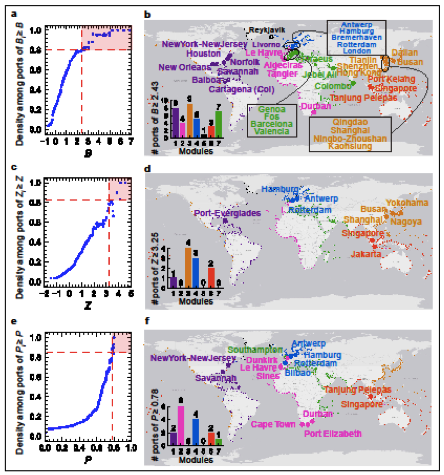THBI scientist unveils how the organization of global maritime transport networks impacts economy by using methods from brain network analysis.
Dr. Carlo Vittorio Cannistraci from THBI is focusing his research on network science applied to biological systems and neuroscience. Recently, he lead a translational study showing how network science computational theories effective for brain analysis can help to understand global shipping networks and their impact on world economy. The study was conducted together with maritime economy scientists from Dalian University of Technology, and has now been published in the scientific journal Nature Communications.
Around 80 per cent of global trade by volume is transported by sea, and thus the connectivity network of the maritime transportation system is fundamental to the world economy and the functionality of its society. To better exploit new international shipping routes, the current ones need to be analysed: What are the principles behind their network organization? What mechanisms determine the complex system association with international trade? However, there is another complex system that, similarly to maritime transportation systems, links the navigability of its network structure and organization to its efficient performance in the environment. This complex system is: the brain. The motivation for this comparative and trans-disciplinary research came from the exchange during an international network science conference, followed by three years of collaborative work on the topic.
"Many complex systems share basic rules of self-organization and economical functionality. When I examined the maritime network structure of the Chinese colleagues at the conference, I advanced the hypothesis that its structure displays a trade-off between high transportation efficiency and low wiring cost, similarly to the one we know is present in brain networks. We combined our knowledge in network science, maritime science and data processing, which led to new insights into the maritime network structural organization complexity and its relevance to international trade", explains Dr. Cannistraci, research group leader for complex network intelligence at THBI. "An important result of this study is the development of new computational network measures for investigation of modular connectivity and structural core organization within complex networks in general, which here we applied to maritime science. In future projects I plan to use these newly developed methods in my research at the BIOTEC where I focus on computational and network systems in biomedicine. They might return particularly useful for brain network organization analysis and the development of markers for brain diseases, such as depression and Alzheimer.”
The study was conducted in collaboration with Dr. Mengqiao Xu, M.S. Qian Pan and Dr. Haoxiang Xia from the Dalian University of Technology (China) and Dr. Alessandro Muscoloni from the Biomedical Cybernetics lab at BIOTEC, TU Dresden (Germany). The study was supported by Alphaliner S.A.R.L. (France), which provided comprehensive data on global liner shipping.
Publication:
Nature Communications: “Modular gateway-ness connectivity and structural core organization in maritime network science”, authors: Mengqiao Xu, Qian Pan, Alessandro Muscoloni, Haoxiang Xia and Carlo Vittorio Cannistraci
Media inquiries:
Dr. Ric. Ing. Carlo Vittorio Cannistraci
Email: cannistraci@mail.tsinghua.edu.cn
Tel: +39 3475954094
Photos:

1. Portrait: Dr. Carlo Vittorio Cannistraci from BIOTEC of TU Dresden

2. Graphic: Representation of the global liner shipping maritime network and its structural core. The color of the nodes corresponds to the ports belonging to different modular communities.
